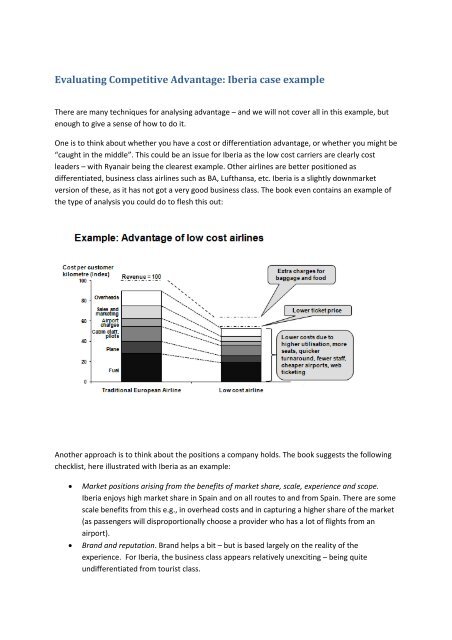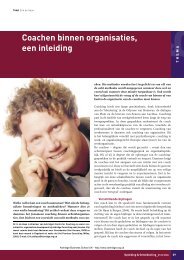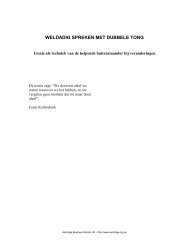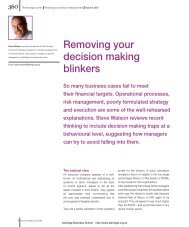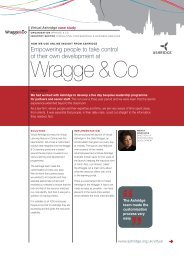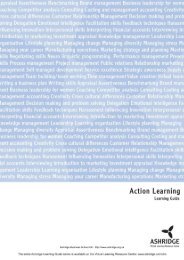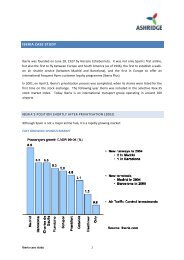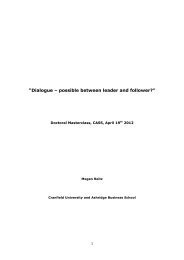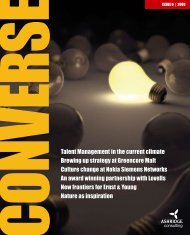Evaluating Competitive Advantage: Iberia case example - Ashridge
Evaluating Competitive Advantage: Iberia case example - Ashridge
Evaluating Competitive Advantage: Iberia case example - Ashridge
You also want an ePaper? Increase the reach of your titles
YUMPU automatically turns print PDFs into web optimized ePapers that Google loves.
<strong>Evaluating</strong> <strong>Competitive</strong> <strong>Advantage</strong>: <strong>Iberia</strong> <strong>case</strong> <strong>example</strong><br />
There are many techniques for analysing advantage – and we will not cover all in this <strong>example</strong>, but<br />
enough to give a sense of how to do it.<br />
One is to think about whether you have a cost or differentiation advantage, or whether you might be<br />
“caught in the middle”. This could be an issue for <strong>Iberia</strong> as the low cost carriers are clearly cost<br />
leaders – with Ryanair being the clearest <strong>example</strong>. Other airlines are better positioned as<br />
differentiated, business class airlines such as BA, Lufthansa, etc. <strong>Iberia</strong> is a slightly downmarket<br />
version of these, as it has not got a very good business class. The book even contains an <strong>example</strong> of<br />
the type of analysis you could do to flesh this out:<br />
Another approach is to think about the positions a company holds. The book suggests the following<br />
checklist, here illustrated with <strong>Iberia</strong> as an <strong>example</strong>:<br />
• Market positions arising from the benefits of market share, scale, experience and scope.<br />
<strong>Iberia</strong> enjoys high market share in Spain and on all routes to and from Spain. There are some<br />
scale benefits from this e.g., in overhead costs and in capturing a higher share of the market<br />
(as passengers will disproportionally choose a provider who has a lot of flights from an<br />
airport).<br />
• Brand and reputation. Brand helps a bit – but is based largely on the reality of the<br />
experience. For <strong>Iberia</strong>, the business class appears relatively unexciting – being quite<br />
undifferentiated from tourist class.
• Value chain design and vertical integration. A significant source of advantage. Ryanair has<br />
redesigned its value chain e.g., outsourcing, lean approach, to have a very different business<br />
model. Top end airlines have executive clubs and elaborate loyalty schemes. So, business<br />
model, or value chain, design is a big differentiator. This is where <strong>Iberia</strong> is somewhat caught<br />
in the middle.<br />
• Access to unique resources or relationships. <strong>Iberia</strong> does probably have some significant<br />
advantages in Spain from its relationships – particularly with airports.<br />
• Input costs. Staff costs may be higher than Ryanair but lower than other airlines – this is not<br />
clear from the <strong>case</strong><br />
• Focus. Being focused on flights to and from Spain provides a distinctive advantage within<br />
that segment of the total industry. But, it is not focused on business or leisure (the offerings<br />
are described as un differentiated) – thus having a disadvantage against some other<br />
competitors (such as Ryanair) more focused on one of these classes.<br />
Capabilities can be analysed in a similar way:<br />
• IT and logistics systems. <strong>Iberia</strong> seems somewhat behind on web‐based ticketing<br />
• Processes. <strong>Iberia</strong>s seems somewhat behind e.g., in the speed with which it can turn planes<br />
around relative to low cost carriers<br />
• Skills. Nothing distinctive indicated<br />
• People. Nothing distinctive indicated<br />
• Organisational structure. Nothing distinctive indicated<br />
• Organisational culture, style, values and behavioural norms. Nothing distinctive indicated<br />
In summary, <strong>Iberia</strong> seems to have no particular strength in it’s capabilities – at least, relative to other<br />
major airline competitors. It has a strong position in Spain but is, in general, in danger of being<br />
caught in the middle – being neither a budget airline nor up with other airlines with respect to its<br />
business class offering. We could then summarise this in the competitive advantage matrix:
From this analysis we conclude that, while <strong>Iberia</strong> has a strong position in the current market – the<br />
sources of advantage are likely to change over time (more exposure to competition – so connections<br />
within Spain will matter less and quality of the brand experience and costs will matter more) and will<br />
need significant efforts by <strong>Iberia</strong> to deal with.<br />
Note that, to do the analysis properly we would have to evaluate competitive advantage for each<br />
segment. To summarise what the outcome might be: advantage is probably is highest in the<br />
domestic market, where there is limited competition, high in some intercontinental markets<br />
(remember, we are only looking at flights to and from Spain ‐ not the global intercontinental market<br />
as a whole) and weakest in Europe – where the low cost carriers are particularly strong.<br />
We do not have enough information to go deeper e.g., to do a value chain analysis of <strong>Iberia</strong>’s<br />
activities, comparing each element of the value chain to its competitors.


